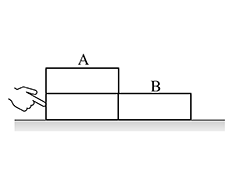
Newton's second and third laws
Variant i Dynamics first Other Variants Interactive tutorial lecture
The tutorial gives students practice in identifying forces, in drawing free-body diagrams, in determining the net force on an object, in applying Newton’s second and third laws, and in identifying appropriate systems of objects.
Topics Mechanics / Newton's Laws: systems, vectors, forces, and free-body diagrams
Materials
Materials by the UW team
- Instructor Guide


- Pretest


- Exam Questions



- Equipment List

Tutorial details
Students begin by identifying the forces acting on each of two systems (system A and system B) that travel across a table at constant speed. System A pushes system B and is itself pushed by a hand. Students give a qualitative ranking of the forces and explain their answers in terms of Newton’s second and third laws. Many students fail to recognize that the sum of the forces is zero when the velocity is constant. After they have considered the situation qualitatively, students are given numerical values for the masses and coefficient of friction and they find the magnitudes of the forces.
In the second part of the tutorial, students consider a similar situation in which the same systems move with increasing speed. This case elicits several common student difficulties. For example, some students believe that since the objects are accelerating, the force by system A on system B is no longer equal to the force by system B on system A.
The third part of the tutorial provides students with practice in considering interacting systems of objects. Questions help students recognize that the forces exerted by parts of the system on other parts do not affect the motion of the system as a whole.
The tutorial ends with an exercise in which students are given a given free-body diagram and asked to come up with a possible corresponding physical situation. This is the reverse of what was expected of them in the previous part of the tutorial. Students are asked questions that help them recognize which aspects of the motion are and are not reflected in a free-body diagram. (e.g., The acceleration can be found from the net force and the angle at which a rope lies can be found from the direction of the tension force, whereas speed and direction of motion are not determined by a free-body diagram.)
For instruction tips, login or register as a verified educator to see the Instructor Guide.
Prerequisites
Students should have worked through the tutorial Forces before working through this tutorial.
Research
- L. McDermott, P. Shaffer, and M. Somers, Research as a guide for teaching introductory mechanics: An illustration in the context of the Atwood's machine, Am. J. Phys. 62 (1), 46 (1994).
Coming Soon! We hope to release the discussion section on each tutorial soon.

